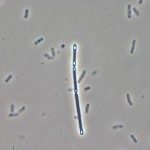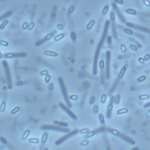Link to Pubmed [PMID] – 7592486
J. Bacteriol. 1995 Dec;177(23):6919-27
There are two levels of control of the expression of the levanase operon in Bacillus subtilis: induction by fructose, which involves a positive regulator, LevR, and the fructose phosphotransferase system encoded by this operon (lev-PTS), and a global regulation, catabolite repression. The LevR activator interacts with its target, the upstream activating sequence (UAS), to stimulate the transcription of the E sigma L complex bound at the “-12, -24” promoter. Levanase operon expression in the presence of glucose was tested in strains carrying a ccpA gene disruption or a ptsH1 mutation in which Ser-46 of HPr is replaced by Ala. In a levR+ inducible genetic background, the expression of the levanase operon was partially resistant to catabolite repression in both mutants, indicating that the CcpA repressor and the HPr-SerP protein are involved in the glucose control of this operon. In addition, a cis-acting catabolite-responsive element (CRE) of the levanase operon was identified and investigated by site-directed mutagenesis. The CRE sequence TGAAAACGCTT(a)ACA is located between positions -50 and -36 from the transcriptional start site, between the UAS and the -12, -24 promoter. However, in a background constitutive for levanase, neither HPr, CcpA, nor CRE is involved in glucose repression, suggesting the existence of a different pathway of glucose regulation. Using truncated LevR proteins, we showed that this CcpA-independent pathway required the presence of the domain of LevR (amino acids 411 to 689) homologous to the BglG family of bacterial antiterminators.

